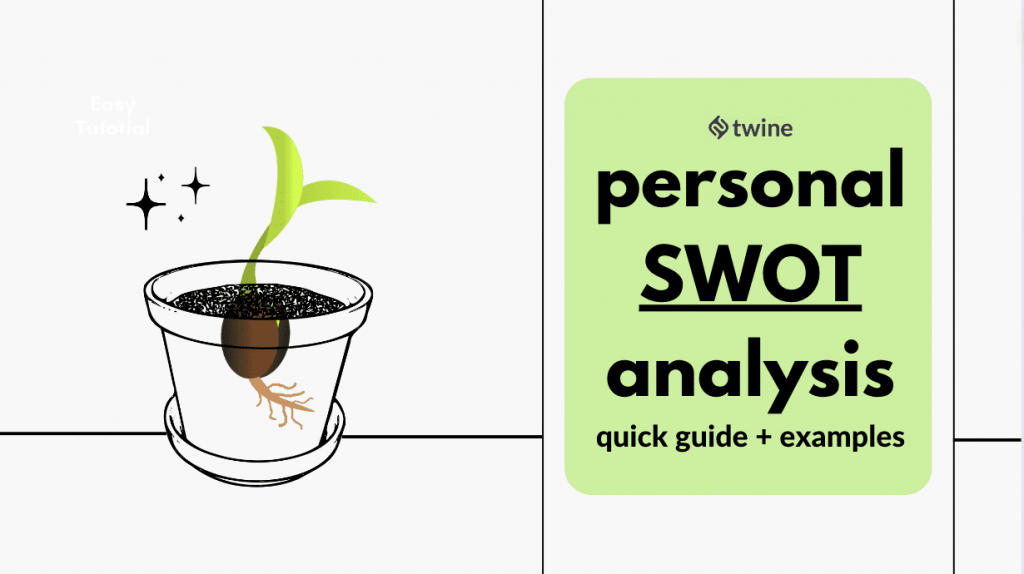
For more Productivity Tools, check out the Freelancer Toolkit…
Every one of us wants to achieve personal goals, be it goals related to our career, relationship, health, or fitness. A personal SWOT analysis is a strategic planning framework to analyze your strengths & weakness and identify threats that could hinder your personal growth.
Pay attention to your present scenario as you conduct the analysis. You can make significant changes in your skillset, habits, and behavior based on the analysis to achieve your goals.
Ready to be recognized as an expert in your field? Join Twine.
What is a Personal SWOT Analysis?
A personal SWOT analysis is a tried and tested method of evaluating one’s strengths and weaknesses. SWOT stands for strengths, weaknesses, opportunities, and threats.
The purpose of a SWOT analysis is not just to list down these things, but to also expand upon them to improve your personal and career growth.
Personal SWOT Analysis vs Business SWOT Analysis
Compared to a business SWOT analysis, which mainly focuses on products and services, a personal SWOT analysis focuses on the individual.
It can be conducted before a job interview or during a job self-evaluation. SWOT analysis can tell you where you stand and what you want to achieve in life.
Benefits of a Personal SWOT Analysis
Every person reflects upon their strengths and weaknesses from time to time. But, a random self-reflection isn’t exactly complex enough to catapult you into super success (whatever that means for you).
With a SWOT analysis, your self-evaluation will be structured. It can help you identify and resolve problems in a manner that’s easy to digest.
For instance, if you only focus on your strengths and ignore your weaknesses, you will never be able to improve. When you write down your weaknesses and the threats you are facing using a SWOT structure, you are more likely to find solutions.
How to Write a Personal SWOT Analysis
Figuring out your strengths and weaknesses is not an easy task.
Personal biases also come into play, making the process of conducting a SWOT analysis even more difficult. However, if you know how to get through every step of the process, it will become easier for you to go through this method of self-evaluation.
Strength Analysis

Before you begin your strength analysis, draw a box on blank paper and divide it into four squares. This will be a rough draft of your SWOT analysis.
In order to figure out your strengths, focus on things that make you different from other people in your industry. For instance, if you are a marketer, and you have a marketing degree – you can add it to your strengths. You can also add any awards, distinctions, and certifications you have in the same niche.
When figuring out your strengths, you don’t have to do everything on your own. Turn to a colleague you trust, and ask their opinion about your abilities. You can also ask friends and family members for a second opinion once you are done listing your strengths.
Examples of what personal strengths can look like:
- I work well under pressure.
- My qualitative and quantitative analysis skills are great.
- I am quick to learn technical concepts.
- I like to stay organized in my personal and professional life.
Weakness Analysis

Before you begin listing down your weakness, it is important to remind yourself that the purpose of this exercise is to improve your personal growth. The goal isn’t to feel bad about yourself by the end!
One of the many benefits of a personal SWOT analysis is that it can just be for your own eyes only.
So, be as open as you want without the fear of judgment. Be honest with yourself and write down the weaknesses that you think are interfering with your growth.
Examples of weaknesses that can keep you from moving forward:
- I am bad at budgeting which results in overspending.
- I shy away from learning technical skills and only focus on artistic skills.
- Brainstorming is easier for me than executing ideas.
- Impatience often occurs with me, which leads to me losing interest in projects halfway through.
Opportunity Analysis

Depending on the purpose behind your SWOT analysis, this part can look different.
For instance, if you are doing a SWOT analysis for career growth, you can look at the opportunities around your workplace. For example, this could be any hobbies you can learn. You should also consider the opportunities that you can create by working on your weaknesses.
Sometimes, opportunities can also arise from your strengths. For instance, if you are good at graphic design, you can use your industry connections to find relevant jobs.
Examples of opportunities to increase growth:
- I can get a promotion if I bring in more sales for three months straight.
- If I sign up for a free online course, I can learn how to build a website.
- I can benefit from my powerful industry connections.
- I can improve professionally by working on my technical skills.
Threat Analysis

Now, figuring out personal threats can be a bit tricky. If you think of yourself as a company or organization, it will become easier for you to figure out what’s hindering your progress.
The threats you are facing can also vary depending on the situation you are in. Certain challenges can affect you in both your personal and professional life.
When thinking of threats, it is important to not only look at factors keeping you from moving forward, but also at the people and environment that amplify their effects.
For instance, if you fail to exercise money management when you are with your college friends, they may be considered a threat to your financial growth.
Threats can also be related to your weaknesses – i.e., if your competitors in the industry can exploit your weaknesses, they will turn into threats. It is important to not only work on your weaknesses but also to find a suitable way to handle situations making things worse for you.
Examples of threats that can hinder your progress:
- My project delivery turnaround is lesser than my colleagues and my boss will prefer them over me.
- New talent is introduced in the field & the competition is fierce.
- I am failing to keep up with the changing technologies in my field, and therefore I am technically not sound.
Example Personal SWOT Analysis:
Okay, let’s say you’re a freelance writer. Using this template, you can see how easy it is to touch upon these 4 points to identify key areas in your growth. Remember, be brutally honest!
Pair your strengths and weaknesses. Analyze threats and opportunities. Finally, plan your future strategy and career path as a freelance writer.
Strengths Hold a degree in the English language A book lover You read a lot You have written content & copy for a wide range of industries You have got more than ten years of experience You are a lifelong learner You have an educational background in Business You are efficient in writing both US English & UK English You can do pretty much great self-branding | Weakness You lose focus Your typing speed is too low You do not understand technical SEO You are not a great technical writer You are a non-native English writer |
Opportunities You can write the same blogs for multiple industries There is whole room for new writers every day as most businesses are expanding digitally You can leverage all the existing platforms and new ones You expand your services to the global audience Get certification for your career growth | Threats With the introduction of AI tools, demand for a writer might diminish in future The market is getting saturated rapidly New talent is introduced into the market New SEO updates are being introduced Rising state taxes makes it hard to scale your earnings |
Conclusion
A detailed personal SWOT analysis will help achieve your personal, health, career, and relationship goals with ease.
Don’t stress over the things as you conduct the analysis. The more realistic you are, the better you can analyze any area you’re lacking or excelling.
Ready to get hired? At Twine, we have dozens of top-quality jobs being posted each and every day. From design to marketing, development to copywriting – there’s a job ready for your skills. Join the marketplace of diverse creative talent here.








